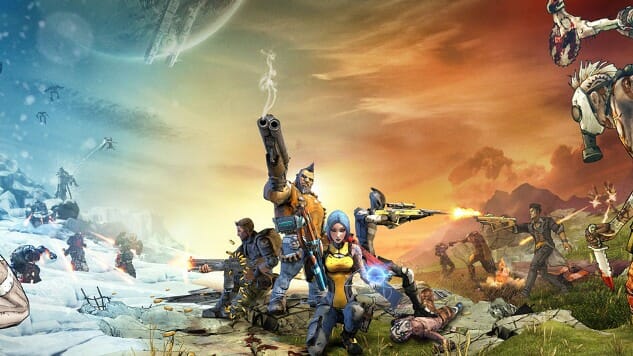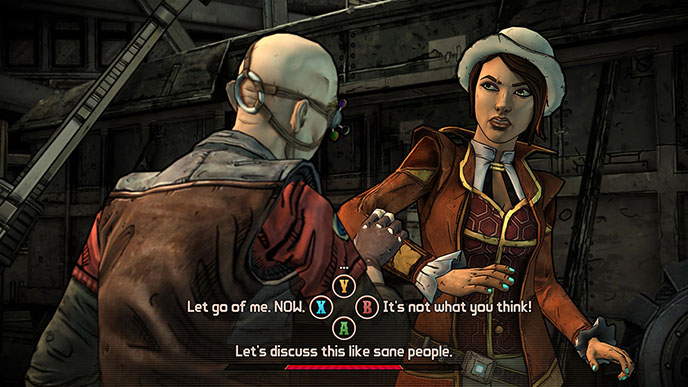
Five years ago, you’d be hard pressed to find me playing any other multiplayer game than Borderlands 2. Or any game, period. Its cel-shaded visual style was oddly stylish and appealing, its crude sense of humor weirdly in step with mine. I loved the way it reminded me of Diablo II while, outside of its class and loot drop system, being nothing like Diablo at all.
A game as big and time consuming, with an element of social, cooperative action, as Borderlands 2 obviously already had a long shelf life. But with a full five years past its initial release, I find it surprising that the inevitable official third installment (the Pre-Sequel doesn’t count) is not yet hyped to death. I’ve seen so many release cycles come and go in the past near-decade of my work, and yet, talk of Borderlands 3 is almost a ghost town. Have I accidentally culled the Borderlands fan base from the orbit of my social world, or is there more to it?
Curious, I put the question to Twitter—not the widest swath, sample-wise, of the games community, but diverse enough that I might see a pattern in the responses. Sure enough, some key points emerged. A few confirmed suspicions I already had and validated my own disinterest, while others surprised me. Generally the consensus is that, yes, the hype is D.O.A. Even megafans like myself, who poured hundreds of hours into the first two games, find their loyalty waning. So what’s gumming up the works?
Tales from the Borderlands left a positive enough impression on me that I’m content to leave that as my last experience with the series
— ???????????????? ???????????????????????????? (@alex_navarro) February 8, 2018
Almost universally it seems Borderlands: The Pre-Sequel is a source of disappointment. While some game-changing concepts like the game’s use of diminished air supply and reduced gravity provided a new challenge, for many, the novelty wore off quickly. The dull environments, set mostly on the darkened moon of Pandora, lacked a day-night cycle or any weather patterns or varied ecosystems that might make the scenery less boring. Combined with the rushed, almost desperate feel of its dialogue and the drop in quality of its jokes, the game felt like, well, exactly what it was: one last attempt at making money off the engine and assets and buying themselves some time before Borderlands 3. It did not feel like a core game, or even a shortened version of a core game in the series, at all.
Tales from the Borderlands has also acted as a double edged sword, having illustrated the storytelling potential behind the series setting and characters, and highlighting Gearbox’s failure to provide a strong narrative base themselves. Telltale Games put a lot more work into making sense of the Borderlands universe than even Gearbox did, and showed fans what could have been if the studio had devoted more time to character development. While it speaks well for Telltale Games, it’s a bad look for Gearbox to be showed up by a spin-off.
Gearbox Software’s track record since Borderlands 2 has also failed to instill confidence. Their best shot at creating their next big hit, Battleborn, was all but lost amid a sea of other team-based shooters and completely eclipsed by Overwatch. Duke Nukem 3D: 20th Anniversary World Tour (a remaster of the original, which Pitchford actually worked on early in his career) failed to improve upon the 1996 original and has been more or less written off as a shameless cash grab. And with the Aliens: Colonial Marines disaster of five years ago still on the minds of many, it does not bode well that Randy Pitchford still seems to be in denial about how bad that game really was.

Another thing the conversation made clear: Destiny is on everyone’s mind. What Borderlands 2 did, Destiny 2 does better. Battleborn has already made it clear that Gearbox struggles to keep up with the big kids and in retrospect the popularity of the original Borderlands sometimes almost seems like an accident. Without its “eleventh hour” switch to cel-shaded graphics (which softened its rough edges and added to the game’s irreverent, campy tone) the game would have likely gotten lost in the shuffle. Destiny, meanwhile, is in the hands of an even bigger publishing studio that knows what it’s doing. While Destiny shares some of the same issues Borderlands has (for example, the repetition of the environments and missions), it’s got the lion’s share of the co-op multiplayer shooter market right now, and Gearbox doesn’t seem to have the resources to maintain, much less compete. It seems fitting, somehow, that a game originally conceived of as a cross between Halo and Diablo will now be forced to compete with one created by Halo’s original studio as a competitor to their first big hit. Will they learn from Destiny, or disappear in its shadow? Again, the Gearbox track record does not bode well.
Some of the team members behind Borderlands 2 have since moved on to other studios and projects, and whether that’s good for the game will depend on how you feel about its tone and sense of humor. Nary a peep has been heard about Borderlands 3 in the past few years, but given how release cycles work, undoubtedly work is already well underway. But will fans give a damn? Following my open query about the missing hype train, one person helpfully suggested a few people to follow online if I want to keep up with the enduring anticipation. While that wasn’t my point of the original question, it at least speaks to the torch that some still carry for this once mega-popular hit series. I suspect for many, the interest is lying dormant until the marketing cycle goes into full swing.
Still, it seems strange that my social media feeds, filled with critics and enthusiasts alike, aren’t packed with the familiar whines of impatient fans. For me personally, too much time has passed. As the image of Borderlands 2 fades in Gearbox’s rear view mirror, what will become of what is arguably its only successful property? Perhaps we’ll get an answer this year at E3 2018.
Holly Green is the assistant editor of Paste Games and a reporter and semiprofessional photographer living in Seattle, WA. She is also the author of Fry Scores: An Unofficial Guide To Video Game Grub. You can find her work at Gamasutra, Polygon, Unwinnable, and other videogame news publications.